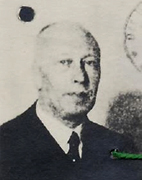Search for Names, Places and Biographies
Already layed Stumbling Stones
Suche

© NIOD Amsterdam
Iwan Hess * 1870
Loogestieg 13 (Hamburg-Nord, Eppendorf)
HIER WOHNTE
IWAN HESS
JG. 1870
FLUCHT HOLLAND
DEPORTIERT 1943
SOBIBOR
ERMORDET
further stumbling stones in Loogestieg 13:
Alice Berju, Ilo Levy
Iwan (Hans) Hess, born 13 Oct. 1870 in Hamburg, deported 27 Apr. 1943 from Westerbork to Sobibór, murdered there 30 Apr. 1943
Loogesteig 13
Iwan Hess married Clara Schmal (née Baer, *8 Aug. 1881 in Straßburg) in 1922. Her first husband, Alfred Schmal (8 July 1879-10 Dec. 1916) was killed in the First World War. She had one son from her first marriage, Kurt Holger (*18 Jan. 1910). He kept his father’s name (see Biographies: Kurt Holger Schmal). Iwan also had a son from his first marriage, Harald Hess (*1899). All trace of him was lost in Berlin in the 1930s. Iwan and Clara were both Jewish, although they had little contact to the Hamburg German-Israelitic Community, which they left in 1935.
Iwan owned the export company J. De Lemos & Hess, located at Neue Wall 54. It specialized in the export of goods to Great Britain, South America and Middle America. In the Hamburg Chief Tax Authority’s report on the "non-Aryan” company from 26 October 1938, the investigators stated that "the company, which has been in existence for many years, was in the past one of Hamburg’s most prominent import and export businesses, with many employees and profits in the millions. In the course of time the business diminished, and today the company is hardly worth mentioning.” The "course of time” was the Nazi Regime, with its harassment and dispossession measures, in which the Tax Authority was an eager and willing participant. By 1938, the "profits in the millions” had been reduced to 45,000 Reichsmarks, and the company had only one employee, a secretary named Fräulein Simnick, who had been there for 17 years and was now working on an hourly basis.
On 1 April 1939, only a few months after the November Pogroms, Iwan Hess closed his office on Neue Wall and turned over the offices to a former business partner and owner of an "Aryan” company, Friedrich Kronacher. He liquidated his company, his life’s work, although there was practically nothing left to liquidate, not even enough for an "Aryanization.”
Iwan Hess was now destitute and had no income. He could no longer afford the apartment at Loogestieg 13, and he and Clara moved into a room at the Lehmann boarding house at Heilwigstraße 46. He was 67 years old, Clara was 56. They eked out a meager existence with dividends from some stock that Clara still owned. This income was so low that it was not frozen, despite a security order that was issued on Clara’s finances on 17 Nov. 1938. 5,000 Reichsmarks – a substantial sum, given the conditions – that Clara had lent the Armin Funk & Co mineral oil company was lost, since the company was unable to repay it.
In this otherwise so dismal year, Iwan and Clara finally received one piece of good news – in late August they received permission to leave the country. And they did so immediately. They emigrated to the Netherlands on 26 August 1939. Just a few days later, after the German invasion of Poland on 1 September and the outbreak of the war, they would no longer have been able to flee.
Their safety lasted only a few months, however. When the Wehrmacht invaded Holland in May 1940, the German administration put its persecution measures into action there, piece by piece. Iwan Hess became one of their victims in the spring of 1943. He and 1203 others were sent from the Westerbork detention camp to the Sobibór Extermination Camp on 27 April. The train arrived there on 30 April, and the mass murder began immediately. Iwan Hess was 72 years old. Clara Hess had died in Amsterdam on 27 September 1942. Her son, Kurt Holger Schmal, was also deported from Amsterdam. He was murdered on 8 April 1945 at the Mauthausen Concentration Camp, aged 35.
Translator: Amy Lee
Kindly supported by the Hermann Reemtsma Stiftung, Hamburg.
Stand: April 2018
© Johannes Grossmann
Quellen: 1; 2; 4; 5; 8 (Kurt Holger Schmahl); StaH 314-15 OFP, R 1938/3048; StaH 314-15 OFP F 2183; StaH 332-5 8939; StaH 332-5 8765; www.joodsmonument.nl (eingesehen am 20.1.2010 und 4.11.2014).
Zur Nummerierung häufig genutzter Quellen siehe Link "Recherche und Quellen".

